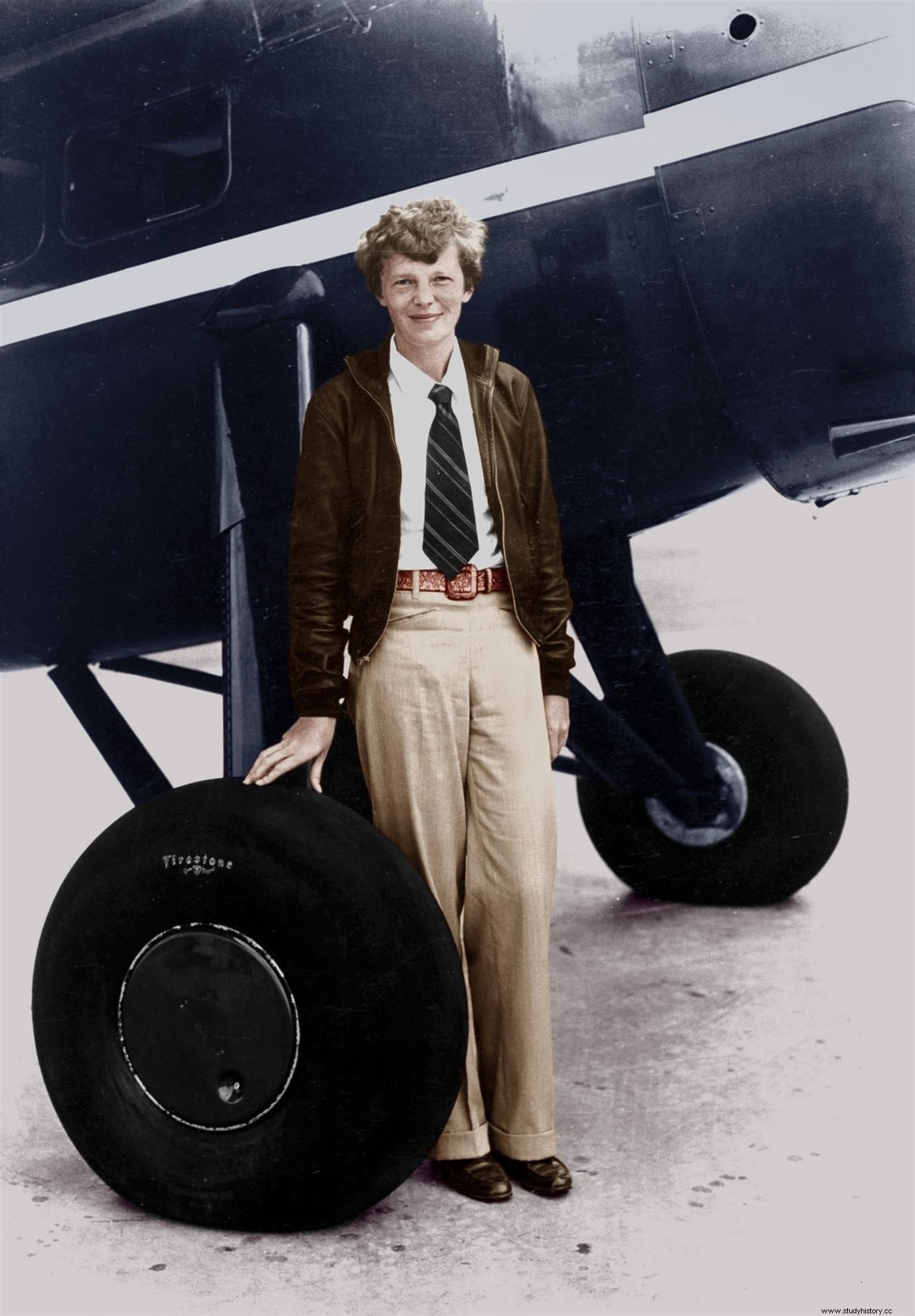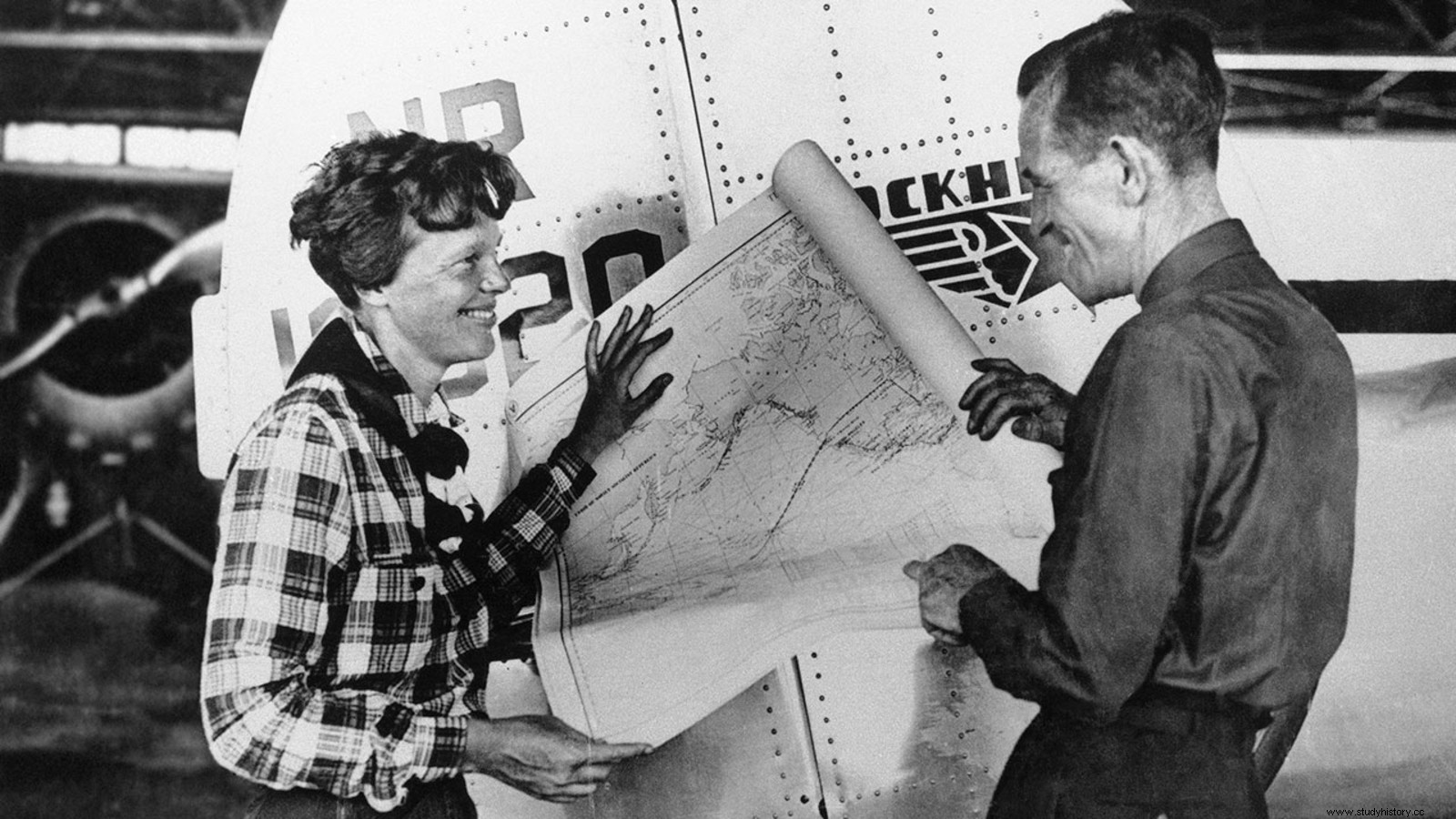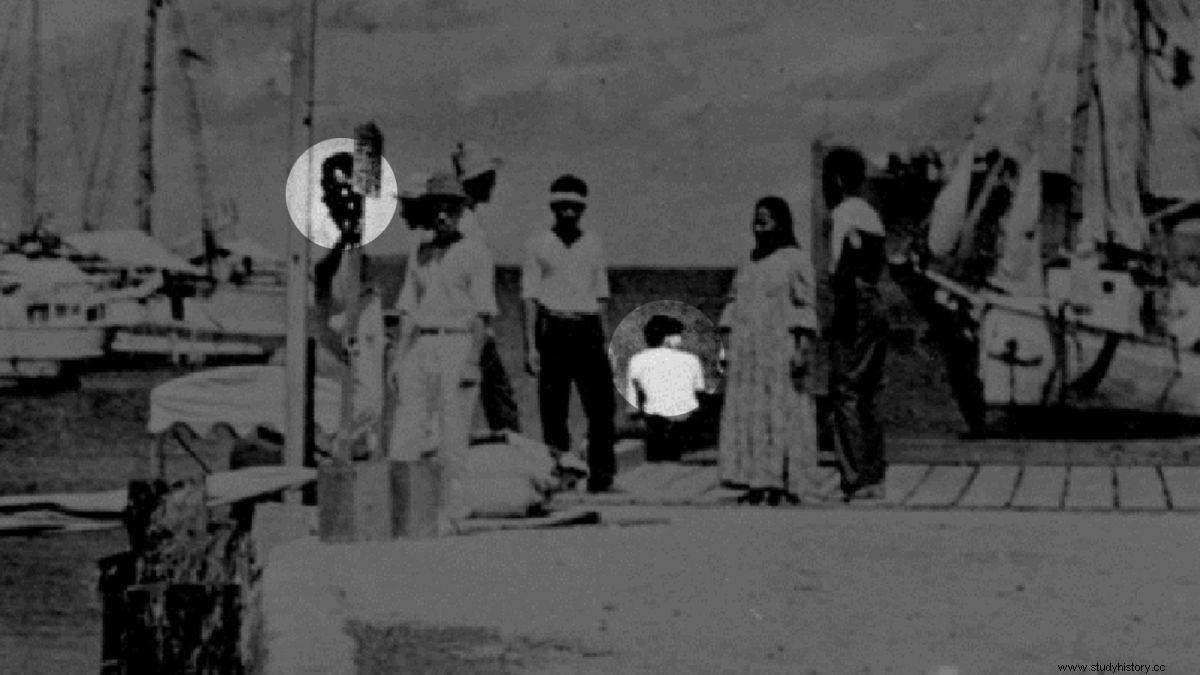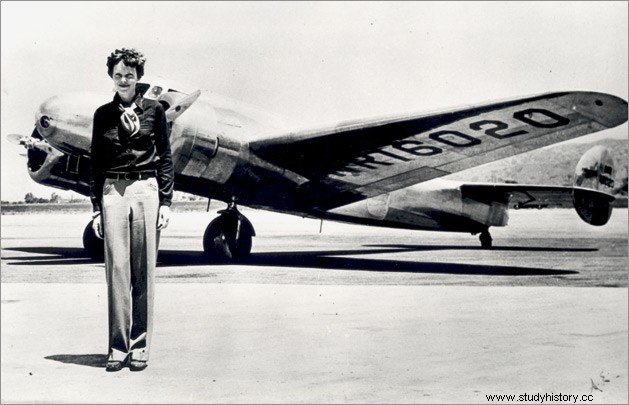A famous pilot whose disappearance triggered theories around the world.
Aviator Amelia Earhart not only broke several world records in the sky, but paved the way for women in commercial flight.
Her disappearance shocked the nation, leading to credible and incredible theories that are still spreading today.
Just like these conspiracy theories, her legacy and heroism live on to this day.
Earhart's Early Life

Amelia Mary Earhart was born on July 25, 1897 in Atchison, Kansas
Her parents were Edwain Stanton Earhart, a railroad lawyer, and Amy Otis Earhart, who came from a wealthy family. Her sister, Grace Muriel Earhart, later Morrissey, became part of the family in 1889.
As a child, she showed her adventurous and independent nature. She defied the stereotypical gender roles of the time.
She played basketball, took a car repair course and even went to university.
In addition, her hairstyle went against the societal norms of female styling in the 1910s.
With the family, Earhart moved from Kansas to Iowa to Minnesota to Illinois.
In 1916, she graduated from high school in Chicago, Illinois.
She decided to play her part in caring for wounded soldiers during World War I (WWI).
In 1917 she served as a Red Cross nurse at Spalina Military Convalescent Hospital in Toronto, Canada.
It was in Toronto that she met pilots. She saw the pilots of the Royal Flying Corps train at a local airport.
Seeing such a feat in the sky started her interest in flying.
After World War I, she returned to the United States (USA) in 1919.
She enrolled at Columbia University in New York as a pre-med student.
However, she completed only one semester after her parents insisted that she live with them in California.
In California, she attended the University of Southern California.
She did not graduate from either.
Earhart's first flight
In December 1920, Earhart took his first flight in California with Frank Hawks, a famous World War I pilot.
This experience made her passion grow.
She started her first flying lessons in January 1921 with the female flight instructor Neta Snook.
To pay for the lessons, she worked as an archive assistant at the Los Angeles Telephone Company.
Two years later, at the age of 25, she bought her first plane. It was a yellow used Kinner Airster which she called "the canary".
In December 1921, she passed the pilot test, and later received a license from the National Aeronautics Association.
Two days later, Earhart participated in his first air show at the Sierra Airdome in Pasadena, California.
Among her many records, she was the first woman to fly solo over 14 meters (000 4200 feet).
Unfortunately, the death of her grandparents and her father's alcoholism led her family to falter.
She sold the Canary Islands.
After her parents divorced, she moved with her mother and sister to Massachusetts.
With the money from the Canary Islands, she bought a car that helped with the family move.
In Massachusetts, she became a social worker at Denison House, a settlement for immigrants in Boston.
Nevertheless, she still pursues her interest in aviation by flying at air shows.
First woman to cross the Atlantic
In the mid-1920s, promoters sought to get a woman to fly across the Atlantic after Charles Lindbergh, the first man to do so in 1927.
Among these promoters was George Putnam, a publisher. He wanted to expand public enthusiasm for Lindbergh's transcontinental flight.
In April 1928, they elected Earhart
Many speculated about the decision, claiming it was based on Earhart's appearance of Lindbergh.
The flight took place on June 17, 1923.
However, Earhart was a passenger on board a seaplane with pilots Wilmer Stulz and Louis Gordon. They left Trepassey, Newfoundland, Canada.
On June 18, 1923, they landed in Burry Port, Wales.
Earhart became an international celebrity, a media sensation and a symbol of what women can achieve.
Putnam remained her promoter and published her two books: 20 Hours. 40 min and Fun with it.
Earhart and Putnam married in 1931.
She kept the maiden name and considered marriage and equal partnership.
Despite praise, Earhart was determined to justify her 1928 fame.
20.-21. May 1932, she left Harbor Grace, Newfoundland, Canada for Londonderry, Northern Ireland.
She experienced a number of problems, such as mechanical difficulties and icy weather.
As a result, she failed to land at her planned destination, Paris.
She crossed the Atlantic in record time, as a pilot, 14 hours and 56 minutes.
After returning to the United States, Congress awarded her the Distinguished Flying Cross, a military decoration for heroism or extraordinary achievement while participating in an aviation flight. She was the first woman to receive the honor.
With her second book published, she completed the first direct flight over the United States by a woman. It took 19 hours, from Los Angeles to Neward, New Jersey.
Remarkable Flights
In 1935, she took the first solo flight from Hawaii to California.
It was a dangerous route of 2408 miles (3875 km), a longer distance than from Canada to Europe.
The flight took 17 hours and seven minutes. She landed in Oakland the next day.
Later that year, she was the first person to fly from Los Angeles to Mexico City.
The Nineteen

In addition to aviation, she urged women to reject restrictive social norms, to pursue various opportunities, especially in aviation.
After finishing third in the first All-Women Air Derby in 1929, she contacted co-pilot Ruth Nichols. She wrote to her about ideas for starting an organization for female pilots.
Together they managed to create such an organization.
The All-Women Air Derby was the first transcontinental women's race.
The organization was formed on November 2, 1929 at Curtiss Field, Valley Stream, Long Island, New York.
117 women gathered for mutual support, the promotion of aviation and the creation of a central office to store files on women in aviation.
The foundation of the organization in 1929 continues to lead it to this day.
In 1931, they elected Amelia Earhart as the first president.
The group then chose the name 'Ninety-nine' to represent the 99 charter members.
Membership opened immediately for other women when they became licensed pilots.
Recently, they opened for women with a pilot certificate.
Today, Ninety-Nines represents female flyers from 44 countries.
The 1937 flight around the world

July 22, 1933, American pilot Wiley Post flew around the world in seven days, 18 hours and 49 minutes.
Post, known for its eye patch, started on July 15. He flew directly to Berlin, to the Soviet Union, and made several stops before returning to North America.
After a few stops in Alaska and Canada, he landed triumphantly at his starting point, New York.
As a brave woman, Earhart set out to fly the world on the Lockhead Electra plane.
The first attempt
For the first try, Earhart, Fred Noonan (a navigator), Harry Manning (naval officer and pilot) and Paul Mantz (Hollywood stunt pilot).
On St. Patrick's Day, March 17, 1937, they left Oakland, California for Honolulu, Hawaii.
Electra needed service in Hawaii and landed in the U.S. Navy's Luke Field on Ford Island in Pearl Harbor.
The flight resumed three days later with Earhart, Noonan and Manning on board.
During the take-off, Earhart went in a ground loop (rapid rotation of a fixed-wing plane in a horizontal plane while on the ground).
The tire blew out and the shock absorber on the landing gear failed. However, there is speculation about these mechanical faults.
As a result, with Electra too damaged, they canceled the flight.
The second attempt
With Noonan, Earhart began his second attempt on May 20, 1937 at Electra.
It started as an eastbound flight from Oakland to Miami.
Electra had several mechanical problems along the way which resulted in further delays.
Final adjustments to the aircraft's engines and instruments were made in Miami.
After that, they were ready to leave.
Although this would not be the first flight around the world, following the equatorial route would make it the longest.
From Miami they went to South America, across the Atlantic to Africa and headed east to India and Southeast Asia.
On June 29, they reached Lae, New Guinea. They flew 22,000 miles (35,000 km) and had 7,000 miles (11,260 km) left.
They left Lae and set course for Howland Island, their next refill stop, June 2nd. It was 2600 km away.
This journey was said to be difficult.
The small coral ring-shaped reef around the island was difficult to find. Being unable to locate it would result in a dangerous landing attempt.
Two brightly lit American ships marked the route.
During the flight, Earhart kept intermittent radio contact with Itasca , a U.S. Coast Guard cutter near Howland.
Later, Earhart radio broadcast that the plane ran out of fuel.
An hour later, she announced, "We are running north and south." This is believed to be the last transmission received by Itasca .
Earhart and Noonan's Disappearance
The Itasca lost all contact with Earhart and Noonan after their last broadcast.
They believe the plane went down 100 km from the island.
President FD Roosevelt authorized a large two-week search for Earhart and Noonan.
They were never found.
On July 19, 1937, the search declared them and Electra missing.
Putnam funded a private search after the end of the official search. It focused near the Pacific Islands and waters.
He became the executor of Earhart's estate to pay for the searches and related bills.
At the end of July 1937, Putnam chartered two small boats.
He remained in the United States and led a search of the Phoenix Islands, Chrisman Island, Fanning Island, Gilbert Islands and Marshall Islands.
At the end of each search, there were no signs of Electra or its pilots.
The court declared Noonan legally dead on June 20, 1938.
For Amelia, Putnam continued the search.
On January 5, 1939, the court declared Earhart legally dead.
Theories of Disappearance

Crash and Sink Theory
This theory states that Earhart's plane ran out of gas while searching for Howland Island.
It crashed into the open sea somewhere around the island and the pilots drowned.
In recent years, there have been attempts to locate the wreckage of the aircraft on the seabed near Howland.
Even with high-tech sonar and deep-sea robots, the attempts failed to find clues about the crash site.
Gardner Island Hypothesis
The International Group of Historic Aircraft Recovery (TIGHAR) believed Earhart and Noonan landed on Gardner Island, a desert island now called Nikumaroro.
After failing to find Howland, they perished as shipwrecks.
This will remain a theory until Electra is healthy.
Captured by the Japanese
From the National Archives, a photograph shows a woman resembling Amelia Earhart sitting on a pier in the Marshall Islands near a man resembling Fred Noonan.
According to this theory, Earhart and Noonan did not crash, but landed on the Marshall Islands. They were then captured by the Japanese.
However, the Japanese authorities insist that they have no record of Earhart or Noonan in their custody.
Earhart and espionage
Some claim that Earhart, in addition to being a pilot, was a government agent.
She never intended to fly to Howland Island.
Together with Nooan, they were commissioned to document the behavior of Japanese island installations to the US government.
During the flight, the Japanese discovered them.
Either they shot down Electra or forced it to land.
A new identity?
Joe Klass published Amelia Earhart live in 1970.
It published one of the wildest conspiracy theories about Earhart's disappearance.
The novel says that she survived the crash in the Pacific Ocean.
After being captured by the Japanese, American forces found and rescued her.
She secretly repatriated to New Jersey and assumed a new identity.
Amelia Earhart became Irene Bolam, a housewife.
The problem with that theory is that Irene Bolam already existed.
Bolam then filed a lawsuit after hearing the news. In addition, she intensely rejected the allegations that she was Amelia Earhart.
Do we ever want to know?
Since the disappearance, there have been various incidents that provide evidence of what happened to Amelia Earhart.
There have been several reports of people having Amelia Earhart's skull or some form of her remains.
In recent years, parts of Electra have claimed to have been found deep in the ocean near Howland.
Everything remains under speculation until proven.
The disappearance of Amelia Earhart, Fred Noonan and Lockhead Electra is one of the world's biggest unsolved mysteries.
the conclusion

We may never know what happened to Earhart from Noonan.
Electra may never be found.
Finally, we are left with inspiring stories of independence, heroism, courage and adventure.
The most difficult thing is the decision to act. The rest is just perseverance. Fear is paper tigers. You can do whatever you decide. You can act to change and control your life and the procedure. The process is its own reward.
- Amelia Earhart, aviator.
